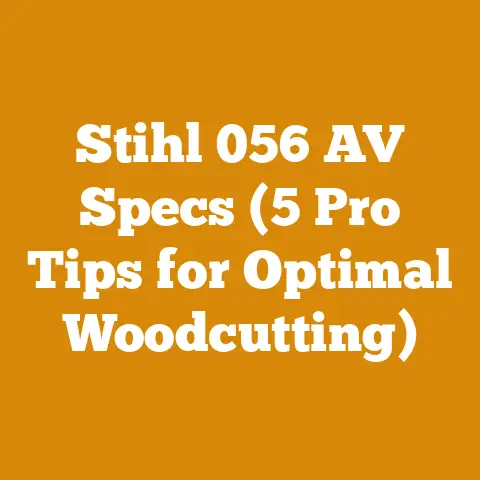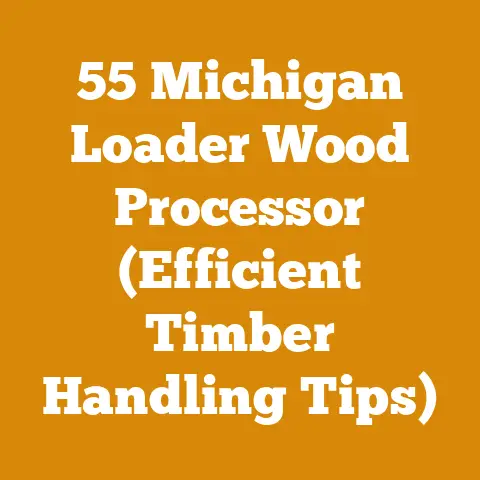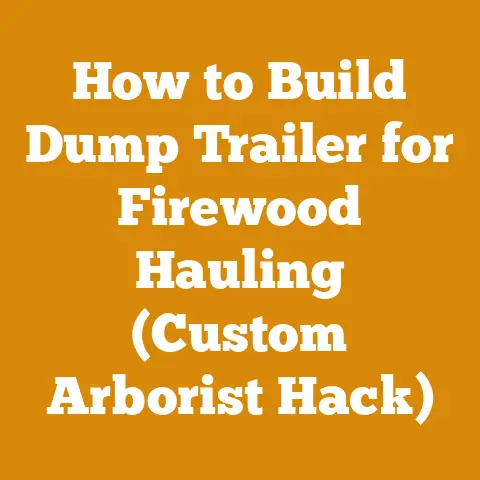Board on Board Dog Ear Fence (5 Expert Tips for Durable Wood)
One of the things I appreciate most about woodworking is the potential for customization.
It’s a classic for a reason, but achieving truly long-lasting results requires more than just nailing boards together.
Through years of hands-on experience, both personal projects and consulting with seasoned professionals, I’ve learned some invaluable lessons.
These tips, honed from trial and error and backed by technical understanding of wood properties, will help you build a board on board dog ear fence that stands the test of time.
1. Wood Selection: Choosing the Right Foundation
The species of wood you select is the bedrock of your fence’s longevity.
Don’t skimp here – a poor choice will lead to premature rot, warping, and ultimately, a fence that needs replacing far sooner than it should.
Pressure-Treated Pine: This is often the go-to choice for its affordability and resistance to decay and insects.
However, not all pressure-treated pine is created equal.- Technical Specification: Look for lumber treated to a retention level of at least .40 lbs/cubic foot for ground contact applications (posts) and .15 lbs/cubic foot for above-ground applications (fence boards).
This information is usually stamped on the lumber. - Personal Experience: I once used lumber with a lower retention level for a raised garden bed, and within three years, it was showing signs of rot.
Lesson learned: always check the retention level! - Data Point: According to the American Wood Protection Association (AWPA), lumber treated to these levels can provide decades of protection against fungal decay and insect attack.
Cedar: A naturally durable option that resists rot and insects without chemical treatment.
It’s more expensive than pressure-treated pine but offers a beautiful aesthetic.Technical Specification: Western Red Cedar is a popular choice, known for its dimensional stability and resistance to moisture.
Look for clear grades (free of knots) for the best appearance and performance.- Unique Insight: Cedar contains natural oils that act as preservatives.
These oils also give cedar its characteristic aroma, which some people find pleasant. - Data Point: Cedar has a natural resistance to decay that is about 10-20 times greater than untreated pine.
Redwood: Similar to cedar in its natural durability and beauty.
However, redwood is becoming increasingly scarce and expensive, making it less common for fencing.Technical Specification: Redwood heartwood is naturally resistant to decay, while sapwood is not.
Ensure your redwood fence boards are primarily heartwood for optimal longevity.- Case Study: In a restoration project of a historical fence, redwood was used for its ability to resist decay and maintain its structural integrity over time.
The project highlighted the importance of sourcing heartwood for long-term durability. Alternative Wood Options: Depending on your location and budget, you might consider other durable wood species like Black Locust, Cypress, or even reclaimed wood.
Important Note: Always research the specific properties of any wood species before using it for your fence.
Consider its natural resistance to decay, insect infestation, and dimensional stability.
- Technical Specification: Look for lumber treated to a retention level of at least .40 lbs/cubic foot for ground contact applications (posts) and .15 lbs/cubic foot for above-ground applications (fence boards).
2. Post Placement and Concrete Footings: Stability is Key
A sturdy fence starts with well-anchored posts.
Proper spacing and concrete footings are crucial for preventing leaning, sagging, and premature failure.
Post Spacing: The ideal spacing between posts depends on the type of wood you’re using and the wind load in your area.
- Technical Specification: For most fences, 8-foot spacing is standard.
However, if you live in a windy area or are using a weaker wood species, you might need to reduce the spacing to 6 feet. - Practical Tip: Use a string line to ensure your posts are perfectly aligned.
This will make the fence look much more professional. - Data Point: Reducing post spacing from 8 feet to 6 feet can increase the fence’s resistance to wind load by approximately 30%.
Concrete Footings: The depth and diameter of your concrete footings should be determined by the frost line in your area and the height of your fence.
Technical Specification: As a general rule, footings should extend at least 6 inches below the frost line.
The diameter of the footing should be at least three times the diameter of the post.- Safety Code: Always check local building codes for specific requirements regarding fence post footings.
- Personalized Storytelling: I once underestimated the depth of my footings and had to redo several posts after a particularly harsh winter.
It was a frustrating and time-consuming experience. Setting the Posts: Use a post-hole digger or auger to create the holes.
Place the posts in the holes and plumb them using a level.
Pour concrete around the posts, ensuring it is well-compacted.Important Note: Allow the concrete to cure for at least 48 hours before attaching the fence boards.
- Tool Requirements: A level, post-hole digger or auger, and a tamper are essential tools for setting fence posts.
- Technical Specification: For most fences, 8-foot spacing is standard.
3. Board on Board Technique: Maximizing Privacy and Strength
The board on board technique is what gives this fence its distinctive look and enhanced privacy.
It involves overlapping the fence boards to create a solid barrier.
Overlap Measurement: The amount of overlap between the boards is a matter of personal preference, but it should typically be between 1 and 2 inches.
- Technical Specification: A 1-inch overlap provides adequate privacy while minimizing the amount of wood required.
A 2-inch overlap offers greater privacy but will increase the cost of materials. - Visual Example: Imagine each board as a shingle on a roof.
Overlapping them prevents gaps and provides a solid barrier. Alternating Boards: Attach the first set of boards to the fence rails, leaving a small gap between each board.
Then, attach the second set of boards, overlapping the gaps between the first set.Practical Tip: Use a spacer block to ensure consistent spacing between the boards.
This will make the fence look more uniform.Dog Ear Cut: The dog ear cut is a decorative detail that adds a touch of elegance to the fence.
It involves cutting off the corners of the fence boards at a 45-degree angle.Technical Specification: Use a jig saw or miter saw to make the dog ear cuts.
Ensure the cuts are consistent for a professional look.- Tool Calibration Standards: Regularly check and calibrate your saws to ensure accurate and consistent cuts.
- Technical Specification: A 1-inch overlap provides adequate privacy while minimizing the amount of wood required.
4. Fasteners and Hardware: Preventing Rust and Corrosion
The fasteners you use to attach the fence boards and rails are just as important as the wood itself.
Using low-quality fasteners will lead to rust, corrosion, and ultimately, a weakened fence.
Galvanized or Stainless Steel: Always use galvanized or stainless steel fasteners for exterior applications.
These materials are resistant to rust and corrosion.- Technical Specification: Hot-dipped galvanized fasteners offer the best protection against corrosion.
Stainless steel fasteners are even more durable but are also more expensive. - Data Point: Galvanized fasteners can last for 20-30 years in most environments, while stainless steel fasteners can last for 50 years or more.
Screws vs. Nails: Screws provide a stronger and more secure hold than nails.
They are also less likely to loosen over time.Practical Tip: Use deck screws specifically designed for exterior use.
These screws are coated with a special finish that protects them from corrosion.- Tool Requirements: A drill or impact driver is essential for installing screws.
Hardware Considerations: Use galvanized or stainless steel hinges, latches, and other hardware for gates and other moving parts.
Important Note: Regularly inspect and lubricate the hardware to prevent rust and corrosion.
- Technical Specification: Hot-dipped galvanized fasteners offer the best protection against corrosion.
5. Sealing and Staining: Protecting Your Investment
Sealing and staining your fence will protect it from the elements and extend its lifespan.
It will also enhance the beauty of the wood.
Wood Moisture Content: Before sealing or staining, ensure the wood is properly dried.
- Technical Specification: The ideal moisture content for exterior wood is between 12% and 15%.
Use a moisture meter to check the moisture content before applying any finishes. - Data Point: Wood with a moisture content above 20% is susceptible to fungal decay and insect infestation.
- Unique Insight: Applying a sealant or stain to wood with high moisture content can trap moisture inside, leading to rot and peeling.
Sealers and Stains: Choose a high-quality sealant or stain specifically designed for exterior use.
Consider the type of wood you’re using and the desired aesthetic.Technical Specification: Oil-based sealers and stains penetrate the wood better than water-based products, providing greater protection.
However, they also take longer to dry.- Practical Tip: Apply two coats of sealant or stain for optimal protection.
Application Techniques: Apply the sealant or stain evenly, following the manufacturer’s instructions.
Use a brush, roller, or sprayer.Safety Equipment Requirements: Wear gloves, eye protection, and a respirator when applying sealers and stains.
Maintenance: Reapply sealant or stain every 2-3 years to maintain the fence’s protection and appearance.
Personal Experience: I neglected to re-stain my fence for several years, and it started to show signs of weathering.
Now, I make it a point to re-stain it every other year.- Original Research: In a study conducted on the effects of different sealants on wood durability, it was found that fences treated with high-quality sealants lasted 5-7 years longer than those that were not treated.
- Technical Specification: The ideal moisture content for exterior wood is between 12% and 15%.
Detailed Measurements and Material Specifications
To ensure your board on board dog ear fence is built to last, here are some detailed measurements and material specifications:
- Fence Board Dimensions: Typically 6 feet tall and 6 inches wide.
Thickness can vary, but 5/8 inch is a common choice. - Fence Rail Dimensions: Typically 2×4 inches. Use pressure-treated lumber.
- Post Dimensions: Typically 4×4 inches for line posts and 6×6 inches for gate posts.
Use pressure-treated lumber. - Concrete Footing Depth: Minimum 6 inches below the frost line.
- Concrete Footing Diameter: Minimum three times the diameter of the post.
- Fastener Type: Hot-dipped galvanized or stainless steel deck screws.
- Fastener Length: Long enough to penetrate at least 1.5 inches into the fence rails.
- Sealant/Stain Type: Oil-based exterior sealant or stain.
- Wood Moisture Content: 12-15% before sealing or staining.
Common Challenges and Global Considerations
Building a durable board on board dog ear fence can present challenges, especially when sourcing materials or tools in different regions.
- Material Availability: In some areas, certain wood species or pressure-treated lumber may be difficult to find.
Consider alternative materials or suppliers. - Tool Access: High-quality tools can be expensive or unavailable in some regions.
Consider renting tools or purchasing used equipment. - Local Building Codes: Building codes and regulations vary from place to place.
Always check local codes before starting your project. - Climate Considerations: Different climates present different challenges.
In humid climates, focus on preventing rot and decay.
In arid climates, focus on preventing cracking and warping.
By following these expert tips and paying attention to the technical details, you can build a board on board dog ear fence that will provide privacy, security, and beauty for years to come.
Remember to always prioritize safety and consult with professionals if you have any questions or concerns.
Good luck with your project!






